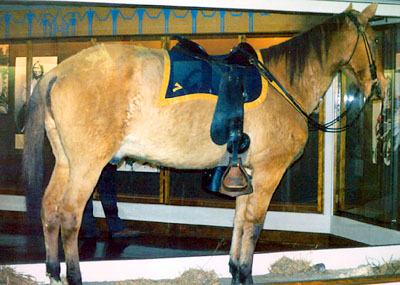|
|
Comanche
Defeat rather than victory brought fame to Comanche.
Comanche, General George Custer's Horse was known as the
sole survivor at the Battle of the Little Bighorn on June 25, 1876.
Comanche was born about 1862, captured in a wild
horse roundup, gelded and sold to the U.S. Army Cavalry on April
3, 1868, for $90. The bay, 925 pounds, standing 15 hands high
with a small white star on his forehead, became the favorite
mount for Captain Myles Keogh of the 7th Cavalry. He participated
in frequent actions of the Regiment and sustained some 12 wounds
as a result of these skirmishes.
He was thought to be a
Morgan Horse.
Two days after the Custer defeat, a burial party investigating
the site found the severely wounded horse and transported him by
steamer to Fort Lincoln, 950 miles away, where he spent the next
year recuperating. Comanche remained here with the 7th Cavalry,
never again to be ridden and under orders excusing him from all
duties. Most of the time he freely roamed the Post and flower
gardens. Only at formal regimental functions was he led, draped
in black, stirrups and boots reversed, at the head of the
Regiment.

When the Cavalry was ordered to Fort Riley, Kansas, in 1888,
Comanche, aging but still in good health, accompanied them and
continued to receive full honors as a symbol of the tragedy at
Little Bighorn. Finally, on November 7, 1891, about 29 years old,
Comanche died of colic.
The officers of the 7th Cavalry, wanting to preserve the horse,
asked Lewis Lindsay Dyche of the University of Kansas to mount
the remains: skin and major bones. For a fee of $400 and on
condition that he be permitted to show the horse in the Chicago
Exposition of 1893, Dyche completed the appropriate taxidermy.
Although there is no record of the fee being paid, the horse was
donated to the university's Museum and property rights are vested
in the University through L.L. Dyche.
Comanche is currently on display in a humidity controlled glass
case at the University of Kansas Museum of Natural History, Dyche
Hall, Lawrence, Kansas.
Back to Famous Horses
|